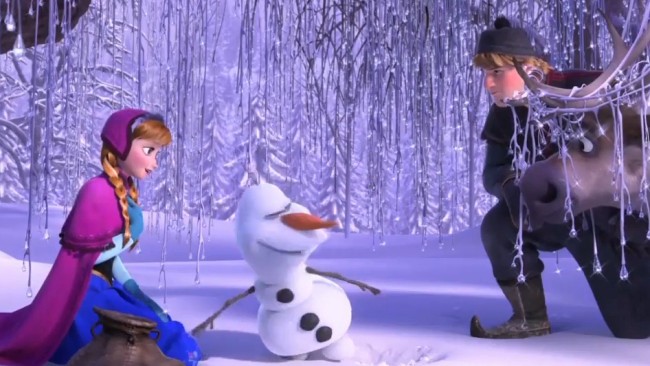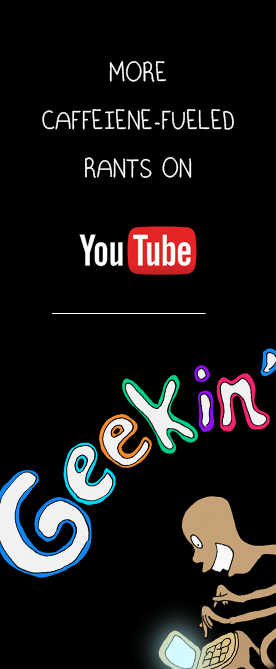Frozen
dir. by Chris Buck & Jennifer Lee
Disclaimer:
It should be noted that I have two four-year-old nieces, so when I say it warms my heart to know that there’s a film like Frozen out there, it’s because of how it affects them, and how it—despite all its tropes and conventions—manages to flip an adult’s expectations and sincerely surprise them. Sure, it’s a movie for everyone, but it’s the little ones that will be most enchanted, which is how it should be. Too many animated films have tragically veered away from the intention of entertaining children, and instead focused their sights on adults who refuse to grow up. As much as I and the rest of America adore Pixar, their films are amply steeped in baby-boomer nostalgia, burdening them with a weight heavier than expected, and a weight more and more difficult to shoulder on repeat viewings. (Ahem! Ahem!: Up anyone?)
Frozen’s simple animation and stock camera compositions are borrowed from the tried-and-true template of Disney’s two previous princess pictures, Tangledand The Princess and the Frog; although, I would venture to say that Frozenhas more in common with Princess than it does Tangled. Both Princess andFrozen have their fair share of conventions and hurdles to clear, but they still introduce enough new elements to the formula to transcend the shackles of the corporate Disney movie machine. Granted, in Princess that new key element—placing a black princess fore and center in a Disney cartoon, egregiously unheard of till then—was a shallow and superficial one: a simple change of color in the skin—but it still accomplished enough to pave the way for such animated anomalies as Frozen.
Frozen isn’t a great film—or necessarily a good one—but it’s definitely an important one.
Elsa and Anna are princess sisters who have drifted apart. Way, way back, when they were still kids, Elsa’s mystical frozen touch grew so volatile it suddenly ruptured and struck Anna upon the face marking her with an arctic-white strand of hair. Fearing that Elsa’s powers may grow too dangerous for public wandering, her parents convinced her to hole up in her room to protect her from anyone and everyone, including her younger sister, who—due to troll-powered sorcery—had long forgotten about Elsa’s icy gift and doesn’t understand why her sister won’t come out and play. The film’s set-up attempts to pull off an Up-like tragedy-in-brevity opening and establish key relationships and context while ineffectively dispatching with Elsa and Anna’s parents. It hits us where it hurts not because the parents are gone, but because their deaths signify the more heartbreaking reality of Anna and Elsa’s subsequent loneliness.
After that, the ball gets rolling fairly quickly and the film introduces us to a plethora of archetypes and conventions, a couple of good ditties, a showstopper in Idina Menzel’s powerhouse ballad “Let it Go,” and a handful of “adult” implications for the older, more sophisticated crowd to pick up on. The film is so short—just under ninety minutes—and so generous on ensemble that it can’t help but short shrift several of its plot threads in lieu of the financially-sound want for increased showtimes. There are several elements of the film that don’t gel as smoothly as the rest—despite their individual charms—such as Olaf the almost-tragically gullible snowman who wants nothing more than to bask in the fatal rays of sunshine. Olaf is a funny and welcome inclusion to a film that’s otherwise bare on wit, as well as a subtle and criminally underplayed symbol of Elsa and Anna’s sisterly unity, but still a character that comes off as nothing more than a superfluous accessory. At no point does he propel plot or action. Even his song—as whimsically disarming as it is—strikes me as a reprieve from loose and thin plotting rather than as a moment of meaningful construction. Even more egregious is the imbalance of screen time between the two sisters. Anna has significantly more screen time than Elsa, banishing Elsa and her concerns off into the unforgiving Siberian tundra of stalled character development. We don’t get as much character building with Elsa as we do Anna, and, even worse, are refused the pleasure of discovering what makes Anna so adamantly obsessed with unearthing her and her sister’s former bond when Elsa is so busy self-pityingly toiling away in her palace of solitude. It also waters down the effect of the film’s pleasantly surprising resolution.
For the most part, the film marches to the same socially-uninformed beat the House of Mouse’s been drumming for the last five decades or so; chugging along, gearing along, by rote, across narrative landscapes we’ve seen dozens of times before. Watching the movie, I could see the cogs of plot and character development churning, predictively, long before the film ever reaches its denouement when Anna freezes over completely from a curse accidentally provided by Elsa. As an adult viewer, once the magical trolls return to warn Anna and her male counterpart Kristoff—a Nordic-looking young man who makes a living by carving and trading ice—that the only remedy for her chillingly spellbound heart is the affection of her true love, I was sure as shit I knew how the story would end.
Alas! my cynicism revealed just how premature my silly quibbles with Frozen’s conventions really were. The film’s main payoff is rather pointless without the story’s calculated penchant for convention. The conventions are meant to throw you off the film’s scent. Because, it’s not Kristoff that ultimately saves Anna from an eternity of cold with a final chivalrous kiss of warmth—as this critic had callously assumed. It’s Elsa. It’s the love of her sibling. The truest love of all.
Just recently, I showed up to my brother’s home and stumbled upon the sight of my two darling nieces watching and singing along to “Let it Go”. They had the entire musical number on lock down, aping Elsa’s every gesture and flourish. I asked my brother and brother-in-law how many times they thought the girls might have watched the movie. Totally shell-shocked by the repetitive bombardment of all that Disney gooey-ness, they could barely gather together enough of their frayed, Frozen-hammered nerves to answer me with a rough estimate. They thought it might be somewhere in the triple digits. But hey, we’re all guilty of it: of once torturing our parents with the inane repition of our favorite childhood movies. My parents claim that my movie-on-loop was The Wizard of Oz. (I don’t know about that. I’m still pretty sure my earliest obsession was a stack of Looney Tunes tapes they gifted me on our first Christmas in the Bronx. But hey, I was three. What do I know?) These were the movies that inevitably coded our outlook on life. I don’t think they mark us in any cataclysmic, Freudian way, but they do certainly—with their own sense of morality and wholesome values—encrypt the way we perceive life. I would much rather have my nieces brainwashing themselves—although, that may be too strong a word—with the idea that their sister is the end all, be all of their capacity for love, that they can rely on their sister for safe haven and support, rather than assume there’s some strange man out there they’ve never met before who will one day inexplicably appear and rescue them from their every problem. In fact, the film preaches a kind of weariness to such quick and empty reliances on men when Anna meets, falls in love with, and engages some young, supposedly valiant prince from a nearby realm—all in the span of a single evening. And—just to put a fine enough point on the ridiculousness of Anna’s unquestionable loyalty to this man she barely knows—the filmmakers eventually reveal the prince as the film’s main baddie.
Frozen isn’t exactly a groundbreaking cartoon. Not at all. Other than a few infectiously foot-tapping numbers, a friendly enough cast of characters, and wondeful array of voiced performances from Kristen Bell, Josh Gad, and Idina Menzel, Frozen is a fairly unremarkable film. But still, it’s that one turn at the end, so endearing, so ideologically sound, so subversive, that automatically catapaults Frozen into the stratoshere of animated greatness—or, at the very least, it will hopefully be considered a film that’s paved the way for even better, more determined kids films that preach something other than the bumblefuck provinciality of movies like Beauty and the Beast, which essentially teaches girls world-wide that it’s okay if your man’s a monster because there will always be women willing to abandon themselves and their goals and ideals to save him from himself. It’s films like Beauty and the Beast that condition girls into believing bullshit gobbledygook like, “Oh, he beats me because he loves me.”
Frozen’s better than that. It may not have the sophisticated storytelling ofBeauty and the Beast, but at least it has the clarity of heart that makes films like Beauty play like outdated relics from a time less informed.
Check Us Out on Stitcher Radio






